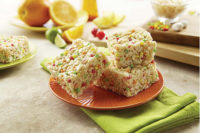Sriracha and bacon have been flavor stars for the past two years, appearing in and on a host of foods. Around the same time, natural blues and greens arrived on the scene, giving snack producers and bakers even more color options. How are these flavors and colors faring now? What’s next?
Ever since consumers discovered Huy Fong Sriracha Hot Chili Sauce (a.k.a. “rooster sauce,” named for the rooster on the front of the bottle) a few years ago, it seems they haven’t been able to get enough of it or sriracha-spiked foods. Snack manufacturers have been happy to oblige, introducing a variety of sriracha-flavored products, including potato chips, popcorn, nuts and beef jerky.
While sriracha continues to be popular for the heat it brings to foods, consumers are experiencing other spicy flavors, as they continue to explore international cuisines known for their fiery dishes.
“We’re still seeing spicy flavors,” says Mike Cantore, vice president of sales, for Carolina Ingredients, Rock Hill, SC, which offers food ingredients and blending services. “People are familiar with spicy, but sriracha’s almost played out now. At one point, it was the next ketchup. A big national brand launched that [flavor], and everybody picked up on it.”
Cantore says he’s now seeing “a little more depth” being added to sriracha. “We’ve had people ask for a creamy sriracha or a sriracha ranch,” he explains. “It goes back to people buying what they’re familiar with, but they want a little bit of a twist on it.”
Other flavors with which Carolina Ingredients recently has been working include Korean barbecue, cheddar and malt vinegar, Caprese (mozzarella, tomato, basil, balsamic vinegar and olive oil), ancient grains (quinoa, faro and others) and peppers. “We’re seeing a resurfacing of peppers,” says Cantore. “We just started [working with] an Aleppo pepper.”
“Spice is in!” agrees Judson McLester, executive chef and ingredient sales manager for Tabasco brand products at McIlhenny Co., Avery Island, LA. “Not just any spice, but those that are linked to history, and provide more than just raw heat. We recently launched a new spray-dried version of our original Tabasco sauce. This item will allow for the authentic flavor of Tabasco to be utilized in multiple baking arenas.”
Wixon Inc., a flavor and seasoning systems producer in St. Francis, WI, created a broad range of trendy seasoning blends this past year, says Jeanne Meeder, director of industrial ingredients and consumer products. Among the flavors it developed to meet consumer demand for hot and spicy foods, including snacks, were Cheddar Habanero, Chipotle Lime, Chili Lime, Flaming Hot Onion, Spicy Nacho, Sriracha, Asian Barbecue and Zippy Chinese Mustard.
Other blends recently created by the company include Guacamole, Avocado Tomato, Cilantro, Raspberry Cream, French Toast, Chocolate Hummus, Dark Chocolate Cherry, Cheesecake and Greek Yogurt.
Double their pleasure
While some consumers crave snacks and baked goods that deliver the heat and flavor of their favorite ethnic foods, others prefer products with flavor combinations that play off of one another, such as spicy-and-sweet, salty-and-sweet and savory-and-sweet.
“Consumers are more open than ever to flavor pairings, whether exotic or traditional,” says Catherine Barry, director of marketing, National Honey Board, Firestone, CO. “Processors are pairing sweet and spicy and sweet and salty flavors. Honey has been a key natural sweetener for both of these pairings, serving as an exceptional balance without overpowering the complete flavor profile.”
While bakers and snack producers have always used honey, Barry says the ingredient’s popularity is booming again. Consumer trends are aligning with honey’s many benefits, which span from flavor to functional to marketing. “As a sweetener, honey imparts exceptional flavors in all bakery foods, from cookies and crackers to breads and rolls to bars and cereals,” she explains. “More importantly, it sweetens bakery foods naturally, and gives bakers a clean-label alternative to other sweeteners.”
Due to its naturally occurring organic acids, honey also enhances the flavors of other ingredients often used in bakery foods, such as spices, fruits and nuts. “When used with cinnamon, herbs, spices or other flavors, honey helps bring out those tastes and aromas,” Barry says.
QualiTech Co. marketing manager Denise Radke says that the Chaska, MN-based manufacturer of food ingredients (particulates, inclusions and savory blends) also is seeing more savory flavors mixed into typically sweet baked goods, such as donuts, muffins and cupcakes. She cites Caramel Sea Salt, Peanut Butter and Jelly, Coconut, Key Lime, Watermelon, Cotton Candy, Lemonade and Birthday Cake as continuing flavor favorites.
“Our scientists understand the overall food chemistry of achieving impactful sweet and savory flavors,” Radke says. “As an example, for savory flavors, our ability to balance the use of natural-based nucleotides, or yeast extract fractions, with natural flavors and plant extracts has been proven. Our bacon, cheese and chipotle inclusions are just a few examples that have less sodium than their counterparts, but have great flavor.”
In the past year, the company has introduced several new sweet-and-savory offerings (Caramel Sea Salt, Mango-Habanero, Honey Chipotle) as well as savory flavors (natural-flavor Bacon, Maple, Wasabi, Sausage, Chili Pepper, Pizza and French Toast) and sweet flavors (Coconut, Orange Dreamsicle, Birthday Cake, Vanilla Icing, Honey, Jumble Berry and Clementine). It also has developed particulates with exotic fruit flavors (tart cherry, acai, pomegranate and mango), and streusel-type toppings for bakery and snack products.
Like QualiTech, Land O’Lakes Ingredients, St. Paul, MN, recently introduced a flavor that combines sea salt and caramel. “Sea-Salted Caramel is a perfect addition to our line of dairy seasonings,” says marketing manager Jim Jarman. “It’s got that rich Land O’Lakes butter base, mixed with a sweet caramel and sea salt, which gives it a totally distinctive, wholesome flavor.” The flavoring can be used in a variety of ingredient applications, including snacks, sauces and dips.
“The sweet-and-salty category has grown in the last two years over 400%,” Jarman adds. “[This product] gives us a chance to demonstrate the expertise we have in dairy-based ingredients.” And it gives Land O’Lakes’ customers an on-trend flavor to use when creating new products.
Tried and true
Like many other food trends, new and unusual flavors that are all the rage one year can be a distant memory the next. Conventional flavors, such as vanilla and chocolate, may see their popularity wane a bit, from time to time, but they continue to be sought out by consumers who appreciate their uncomplicated, go-to tastes.
“While exotic flavors have been popular in the recent past, right now, classic flavors are making a comeback,” says Craig Nielsen, CEO of Nielsen-Massey Vanillas Inc., Waukegan, IL, which offers vanilla extracts, pastes, powder, sugar and whole beans; and pure almond, chocolate, coffee, lemon, orange and peppermint extracts. “There are always new trends on the radar, but cinnamon, fruit and, of course vanilla and chocolate, are classic favorites that will always predominate the snack and baked goods category.”
While vanilla is the company’s flagship and signature flavor, Nielsen-Massey Vanillas recently introduced two products that bakers can use to add an extra aromatic quality to traditional flavors. “Adding a hint of Nielsen-Massey Orange Blossom Water to a peach baked good or scenting strawberries with Nielsen-Massey Rose Water are ways for bakers to elevate traditional flavors and separate their products from those of their competitors,” says Nielsen.
Color their world
New flavors and consumer trends influence the colors bakers and snack producers choose for products. After all, most consumers expect a food’s color to be reflective of its flavor—orange cheese curls, white angel food cake and brown rye bread.
“At Wixon, we’re seeing more requests for punched-up, bright red and orange colors that reflect the increased heat of flavors such as Sriracha, Flaming Hot, Hot Cheese and Spicy Hot,” says Meeder.
Similarly, Rajesh Cherian, product manager-natural colors, ROHA USA, St. Louis, sees popular snack brands using shades of red to enhance the flavor appeal of their ethnic and spicy hot flavor introductions. Naturally sourced reds include red beet juice powders, anthocyanins, paprika oleoresin, lycopene and carmine.
While Carolina Ingredients doesn’t make colors, it uses natural greens in some of its products. “We’re using them for guacamole because people are going to want a greener color in a guacamole,” says Cantore. “We can [also use it to] give oregano that leafy green color.”
Wixon is also receiving more requests for natural greens that deliver on the green trends like kale and avocado flavors, Meeder says.
Natural blues are now also available to bakers and snack manufacturers. QualiTech offers these colors in its inclusions, says Radke.
As with flavors, some colors—cheese shades, for instance—will continue to be popular among bakers, snack producers and consumers. “Traditionally, a series of yellow, orange and browns dominate the bakery industry,” says Cherian. “‘Egg shades’ are considered a standard for many baked products, like muffins, breads, and cakes. Synthetic colors—yellow 5 and yellow 6 and their blends—are widely used in industry. Turmeric oleoresins, annatto, beta-carotenes and other carotenoids are heat-stable coloring options from natural sources classified as exempt colors by the Food and Drug Administration (FDA).”
Artificial versus natural
When it comes to consumer demand for baked goods and snacks made with artificial or natural flavors and colors, products made with the latter are quickly gaining ground on the former.
“What started as a trend, natural products have quickly received a tidal wave of requests,” says Nielsen. “Long, complicated ingredient decks are giving way to simple ingredients anyone can understand and want to consume. Consumers are passing by products full of chemical compounds created in a lab and instead are turning to products that can be found in nature.”
Bakers and snack manufacturers are turning to ingredient suppliers for such solutions to help them reformulate and create products to address this trend.
“It seems everyone is striving for simplicity in their ingredient declaration, and the use of natural flavors and colors are a key part of that trend,” Radke says. “Consumers are more concerned about the quality of the foods they are eating and the ingredients in them. We’re customizing our offerings and making simpler labels [featuring] natural ingredients.”
“That’s almost all we do now,” says Cantore, of natural flavors and colors. “We’ve had a lot of people request them, especially for new snacks.”
And while Cherian also acknowledges that there’s growing demand for colors from natural origins, he says ROHA hasn’t seen a drop in demand for artificial colors. “Compared to natural [colors], synthetic colors are more stable and cost-effective in bakery and snack food applications,” he explains.
The cost of natural
Consumers demand for products made with natural ingredients, including flavors and colors, continues to grow. Bakers and snack manufacturers, meanwhile, know that delivering affordable products that meet these requisites often can be challenging due to factors impacting their ingredient suppliers.
Says Nielsen, “There is one strong variable—the cost of our largest raw material: Vanilla beans. The crop is annual, and weather, demand cycles and competition play major roles in its availability and cost.”
ROHA’s Cherian concurs: “Colors from natural origins are impacted by crop situations, which are affected by climatic conditions and socioeconomic issues in the growing region.” He adds that a reliable crop-monitoring system and advance demand forecasting are keys to avoiding unfavorable situations.
McLester cites seasonality and cost as factors impacting the availability of natural flavors and colors. “As more defined flavors are being created, you encounter a seasonality of ingredients,” he says. “This can be managed long-term, but can prove difficult for quick turnaround projects. Cost, as always, has a direct relationship with the quality of capture and processing. However, the best flavors, although expensive, can have a reduced use rate, while providing far more impact.”
Barry agrees: “Honey can be more expensive than other natural sweeteners, but its use in a bakery food turns an ordinary product into a premium product that can command a premium price.”
What’s next?
Despite the profusion of artificial and natural flavors and colors already available to bakers and snack manufacturers, ingredient suppliers will continue to monitor consumer trends and develop products to help their customers succeed in their categories.
According to Radke, upcoming color trends will likely include an increase in the use of natural blue colors, which recently received FDA approval for confectionery applications, and will likely be approved for other categories within the food industry.
When it comes to flavors, she says QualiTech is seeing more on the savory side, like Maple Bacon, Pumpkin, Ash (charred food, fire & smoke), Sweet Potato and Green Tea; Caramel, Key Lime, Coconut and Chocolate and Chili Peppers on the sweet side; and seasonal flavors.
So whether consumers start clamoring for snacks and baked goods that are hot, sweet, sophisticated, red, blue, green or some other trending flavor-color combination, bakers and snack manufacturers will be able to meet their requests, thanks to their ingredients suppliers.










